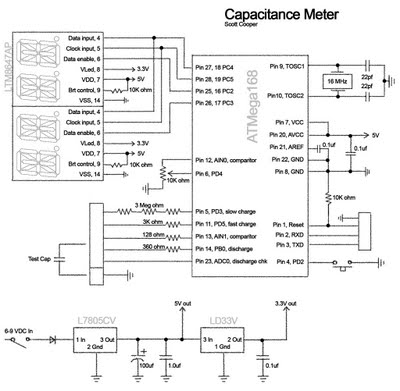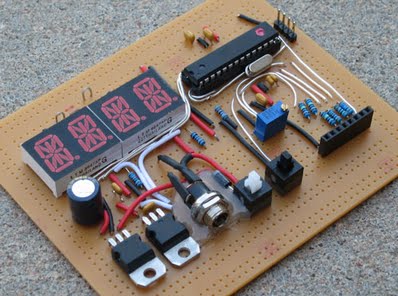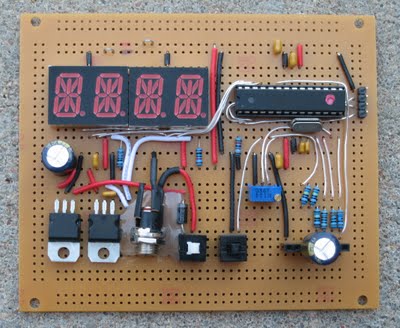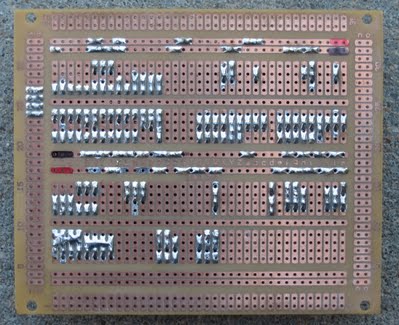Capacitance Meter
Arduino Capacitance Meter and RC time constants
Sparkfun kit
Sparkfun kit, schematic
http://elm-chan.org/works/cmc/report.html
More capacitance info

I really need to get some thinner wire for these kinds of things. Dragging around a solid 20 gauge wire around my breadboard to carry fractions of an amp is silly.
/* RCTiming_capacitance_meter
* Paul Badger 2008
* Demonstrates use of RC time constants to measure the value of a capacitor
*
* Theory A capcitor will charge, through a resistor, in one time constant, defined as T seconds where
* TC = R * C
*
* TC = time constant period in seconds
* R = resistance in ohms
* C = capacitance in farads (1 microfarad (ufd) = .0000001 farad = 10^-6 farads )
*
* The capacitor's voltage at one time constant is defined as 63.2% of the charging voltage.
*
* Hardware setup:
* Test Capacitor between common point and ground (positive side of an electrolytic capacitor to common)
* Test Resistor between charge_pin and common point
* 220 ohm resistor between discharge_pin and common point
* Wire between common point and analog_pin (A/D input)
*/
#define analog_pin 0 // analog pin for measuring capacitor voltage
#define discharge_pin 8 // pin to discharge the capacitor
#define analog_voltage_pin 0 // pin 14 to read the discharge value
#define comparitor_state_pin 4 // pin
int fast_charge_pin = 5; // pin to charge the capacitor - connected to one end of the charging resistor
int slow_charge_pin = 3; // pin to charge the capacitor - connected to one end of the charging resistor
int current_charge_pin = 0;
int calibrate_pin = 2;
float resistorValue; // change this to whatever resistor value you are using
// F formatter tells compliler it's a floating point value
volatile byte event;
#define total_chars 4
#define clock_pin 19 // set clock pin
int data_enable_pins[] = {17, 16}; // set slave select pins
int data_pins[] = {18, 18}; // set master out, slave in pins
int font[64];
int c;
char buf[16] = "";
unsigned long calibrate_time = 184; // Initial calibration value unsigned long start_time;
unsigned long elapsed_time;
volatile unsigned int count = 0;
volatile unsigned long interrupt_time;
float micro_farads; // floating point variable to preserve precision, make calculations
float nano_farads;
float pico_farads;
///////////////////////////////////////////////////////////////////////////////////////////////////////
void setup(){
pinMode(analog_voltage_pin, INPUT);
Serial.begin(19200); // initialize serial transmission for debugging
setup_led();
// Set comparitor AIN1 (positive pin) to 3.160v, 63.212% * 5v, time constant 1
// Time constant 1: 63.212%
// Time constant 2: 86.466%
// Time constant 10: 99.995%
// More info at: http://www.allaboutcircuits.com/vol_1/chpt_16/4.html
pinMode(comparitor_state_pin, OUTPUT);
digitalWrite(comparitor_state_pin, HIGH);
pinMode(calibrate_pin, INPUT);
digitalWrite(calibrate_pin, HIGH); //Turn on pull up resistors
ACSR = (0< 1) {}
delay(100);
}
///////////////////////////////////////////////////////////////////////////////////////////////////////
char *ftoa(char *a, double f, int precision) {
long p[] = {0,10,100,1000,10000,100000,1000000,10000000,100000000};
char *ret = a;
long heiltal = (long)f;
itoa(heiltal, a, 10);
while (*a != '\\0') a++;
*a++ = '.';
long desimal = abs((long)((f - heiltal) * p[precision]));
itoa(desimal, a, 10);
return ret;
}
///////////////////////////////////////////////////////////////////////////////////////////////////////
void output_results(){
unsigned long time;
char stmp[20];
//char ascii[16];
Serial.print("Elapsed: ");
Serial.print(elapsed_time);
Serial.print(" Calibrate: ");
Serial.print(calibrate_time);
Serial.print(" Resistance: ");
Serial.print(resistorValue);
if(elapsed_time > calibrate_time) {
time = elapsed_time - calibrate_time;
} else {
time = 0;
}
Serial.print(" Time: ");
Serial.print(time);
// convert microseconds to seconds ( 10^-6 ) and Farads to micro_farads ( 10^6 ), net 1
micro_farads = ((float)time / resistorValue);
if (micro_farads >= 1){
//Serial.print((long)micro_farads);
//Serial.println(" micro_farads");
Serial.print(" ");
Serial.print(micro_farads);
Serial.print(" micro_farads");
format_for_led (micro_farads, 'u');
} else if (micro_farads >= 0.001){
// if value is smaller than one microFarad, convert to nano_farads (10^-9 Farad).
// This is a workaround because Serial.print will not print floats
nano_farads = micro_farads * 1000.0; // multiply by 1000 to convert to nano_farads (10^-9 Farads)
Serial.print(" ");
Serial.print(nano_farads);
Serial.print(" nano_farads");
format_for_led (nano_farads, 'n');
} else {
// if value is smaller than one microFarad, convert to nano_farads (10^-9 Farad).
// This is a workaround because Serial.print will not print floats
pico_farads = micro_farads * 1000000.0; // multiply by 1000000 to convert to pico_farads
Serial.print(" ");
Serial.print(pico_farads);
Serial.print(" pico_farads");
format_for_led (pico_farads, 'p');
}
Serial.println();
}
///////////////////////////////////////////////////////////////////////////////////////////////////////
void format_for_led (float farads, char scale) { char ascii[8];
float temp = farads;
//temp = 314.159265;
if (temp >= 999.0) {
sprintf(ascii, "OVER ", 1);
} else {
int temp1 = (temp - (int)temp) * 100;
//Serial.print(" temp: ");
//Serial.print(temp);
//Serial.print(" temp1: ");
//Serial.print(temp1);
sprintf(ascii, "%0d.%02d", (int)temp, abs(temp1));
//Serial.print(" ascii-1: ");
//Serial.print(ascii);
sprintf(ascii, "%-4.4s%c ", ascii, scale);
//Serial.print(" ascii-2: ");
//Serial.print(ascii);
}
print_led(ascii);
Serial.print(" Display: ");
Serial.print(ascii);
Serial.print(" ");
}
///////////////////////////////////////////////////////////////////////////////////////////////////////
// LITE-ON, LTP-8647AP, 2 digit, 14-Segment Red LED
// Jameco.com, part no. 1955933, $2.95
// http://www.jameco.com/webapp/wcs/stores/servlet/Product_10001_10001_1955933_-1
//
// Code by Scott Cooper
// The code is setup to multiplex the data_pins and the data_enable_pins.
// This allows for a single ATMEGA168 to run up to 100 chips or 200 characters at a time (10x10)
// In this example the first chips is connected to pins 3 and 5.
// The second chip is connected to pins 4 and 6.
// All chips will use the same clock.
// The only pins needed to run the LTP-8647 chip:
// 4 data enable
// 5 clock
// 6 data
// 7 +5vdc
// 8 +3.3vdc
// 9 12k resistor going to Gnd, brightness
// 14 Gnd
///////////////////////////////////////////////////////////////////////////////////////////////////////
void setup_led() {
// Add 32 to the font index to get the corresponding ASCII value
font[0] = 0; // space
font[1] = 6144; // !
font[2] = 272; // "
font[3] = 16383; // #
font[4] = 11730; // $
font[5] = 2541; // %
font[6] = 11309; // &
font[7] = 8; // '
font[8] = 12; // (
font[9] = 33; // )
font[10] = 255; // *
font[11] = 210; // +
font[12] = 1; // ,
font[13] = 192; // -
font[14] = 1666; // .
font[15] = 9; // /
font[16] = 16137; // 0
font[17] = 6144; // 1
font[18] = 14016; // 2
font[19] = 15424; // 3
font[20] = 6592; // 4
font[21] = 9604; // 5
font[22] = 12224; // 6
font[23] = 14336; // 7
font[24] = 16320; // 8
font[25] = 15808; // 9
font[26] = 18; // :
font[27] = 17; // ;
font[28] = 12; // <
font[29] = 1216; // =
font[30] = 33; // >
font[31] = 12354; //
font[32] = 14160; // @
font[33] = 15296; // A
font[34] = 15442; // B
font[35] = 9984; // C
font[36] = 15378; // D
font[37] = 10176; // E
font[38] = 9088; // F
font[39] = 12096; // G
font[40] = 7104; // H
font[41] = 18; // I
font[42] = 7680; // J
font[43] = 908; // K
font[44] = 1792; // L
font[45] = 6952; // M
font[46] = 6948; // N
font[47] = 16128; // O
font[48] = 13248; // P
font[49] = 16132; // Q
font[50] = 13252; // R
font[51] = 11712; // S
font[52] = 8210; // T
font[53] = 7936; // U
font[54] = 777; // V
font[55] = 6917; // W
font[56] = 45; // X
font[57] = 42; // Y
font[58] = 9225; // Z
font[59] = 9984; // [
font[60] = 36; // backslash
font[61] = 15360; // ]
font[62] = 12297; // ^
font[63] = 1024; // _
pinMode(clock_pin, OUTPUT); // set SCK pin to output
for (int i=0; i pinMode(data_enable_pins[i], OUTPUT); // set CS pin to output
digitalWrite(data_enable_pins[i], HIGH); // hold slave select 1 pin high, so that chip is not selected to begin with
}
for (int i=0; i pinMode(data_pins[i], OUTPUT); // set MOSI pin to output
}
print_led(" ");
}
///////////////////////////////////////////////////////////////////////////////////////////////////////
void print_led (char mystr[]) {
for (int i=0; i spi_out(data_pins[(i+1)/2], data_enable_pins[(i+1)/2], mystr[i], mystr[i+1]);
}
}
///////////////////////////////////////////////////////////////////////////////////////////////////////
void spi_out(int data_pin, int data_enable_pin, char c1, char c2) {
unsigned long working;
if (c1 >= 97 && c1 <= 122) { c1-=32; } // check for lower case
if (c2 >= 97 && c2 <= 122) { c2-=32; } // check for lower case
if (c1 < 32) { c1=' '; } // check for too small
if (c2 < 32) { c2=' '; } // check for too small
if (c1 > 95) { c1=' '; } // check for too big
if (c2 > 95) { c2=' '; } // check for too big
c1-=32;
c2-=32;
working = 1;
working = working << 14;
working += font[c2];
working = working << 14;
working += font[c1];
working = working << 3;
// Bits 32, 33 & 34 are not accessible because the long is only 32 bits.
digitalWrite(data_enable_pin, LOW); // set low to enable this led.
for(int i = 0; i <= 35; i++) {
digitalWrite(clock_pin, LOW);
//if(i == 2) { Serial.print(" "); }
//if(i == 16) { Serial.print(" "); }
//if(i == 30) { Serial.print(" "); }
//if(i == 33) { Serial.print(" "); }
if (working > 2147483647) { // test the most significant bit
//Serial.print("1");
digitalWrite (data_pin, HIGH); // if it is a 1 (ie. B1XXXXXXX), set the master out pin high
} else {
//Serial.print("0");
digitalWrite (data_pin, LOW); // if it is not 1 (ie. B0XXXXXXX), set the master out pin low
}
digitalWrite (clock_pin,HIGH); // set clock high, the pot IC will read the bit into its register
working = working << 1;
}
//Serial.print(" ");
//Serial.print(c2, BYTE);
//Serial.print(" ");
//Serial.print(c1, BYTE);
//Serial.println();
digitalWrite(data_enable_pin, HIGH); // set high to disable this led.
}
created: Dec. 1, 2013, 1:01 a.m.
modified: April 14, 2019, 12:44 a.m.



